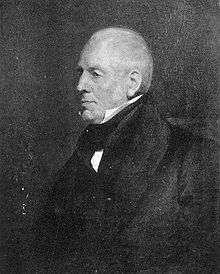Archibald Menzies

Archibald Menzies (/ˈmɪŋɪs/ MING-iss; 15 March 1754 – 15 February 1842) was a Scottish surgeon, botanist and naturalist.
Life and career
Menzies was born at Easter Stix (or Styx) in the parish of Weem, in Perthshire.[1] While working with his elder brother William at the Royal Botanic Gardens, he drew the attention of Dr John Hope, professor of botany at Edinburgh University, who encouraged him to study medicine there. Having qualified as a surgeon, Menzies served as assistant to a doctor in Caernarvon, then joined the Royal Navy as assistant surgeon on HMS Nonsuch. Present at Battle of the Saintes (12 April 1782), in peacetime Menzies served on Halifax Station in Nova Scotia.
In 1786 Menzies was appointed surgeon on board the Prince of Wales (Captain James Colnett), on a fur-trading voyage round Cape Horn to the northern Pacific. This ship, in company of Princess Royal (Captain Duncan), visited North America, China and Hawaii (the Sandwich Isles) several times; Menzies collected a number of new plants on this voyage, and also ensured that none of the crew died of illness. Menzies returned to Great Britain in 1789. He was elected a fellow of the Linnean Society in 1790.
In 1790, Menzies was appointed as naturalist to accompany Captain George Vancouver on his voyage around the world on HMS Discovery.[2][3] (see Vancouver Expedition) When the surgeon fell ill, Menzies took over his duties.

In 1794, while Discovery spent one of three winters in Hawaii, Menzies, with Lieutenant Joseph Baker and two other men, made the first recorded ascent to Mokuaweoweo, the summit of Mauna Loa. Menzies used a portable barometer to measure the height of the mountain as 13564 feet (4134m) compared to its currently known height of 13679 feet (4169m).
It would be forty years before another European, fellow Scotsman David Douglas, would reach the summit on 29 January 1834.[2] He dropped off citrus fruit seeds that had been picked up in South Africa, so that future ships might be able to replenish their stocks at the Hawaiian islands.[4]
In 1795, Menzies was served the seeds of the Chile Pine, Araucaria araucana, as a dessert while dining with the Viceroy of Chile. He was able to pop some seeds into his pocket and grow them on board ship on the way back to Europe, and returned to England with five healthy plants, the first seen in Britain.[5] Known as the Monkey Puzzle tree, the Chile Pine became a favourite in most formal gardens of the nineteenth century.
After the voyage, Menzies served with the Navy in the West Indies. He received the degree of M.D. at the University of Aberdeen in 1799. After retiring from the Navy he became a doctor and surgeon at Notting Hill, London. He became the leader of the Linnean Society upon the death of A.B. Lambert.
Menzies's wife died in 1837. They had no children.
Menzies himself died in London on 15 February 1842 and is buried in Kensal Green cemetery.
Legacy
Menzies' name is commemorated in the scientific names of several of the plants he discovered, including Menziesia, a genus of shrubs in the Ericaceae, and the Douglas-fir Pseudotsuga menziesii, the most commercially important tree in western North America.[6] The Pacific madrone, an evergreen tree and largest of the Ericaceae, was named Arbutus menziesii in his honour by Friedrich Pursh. Also named for Menzies, in a corrupted form as adapted by the Nuxalk people of the Bella Coola area of the Central Coast of British Columbia, is "Bensins Island", as recorded by Alexander Mackenzie during his visit there shortly after Vancouver's ship visited the area.[7] The Ainapo Trail he used to climb Mauna Loa is also known as "Menzies Trail".[8]
Many of the specimens collected by Menzies are planted in London" Kew Gardens. He also brought back to London 112 separate collections of artifacts, which are housed at the British Museum. A comprehensive catalog of these collections was not published until 1951.[9]
See also
References
- ↑ Birth (or Baptism) Record held in the General Registers of Scotland, 1754 Births in the Parish of Weem in the County of Perth, Reference 398/0010 0104
- 1 2 Archibald Menzies (1920). William Frederick Wilson, ed. Hawaii Nei 128 Years Ago:Journal of Archibald Menzies, kept during his three visits to the Sandwich or Hawaiian Islands in the years 1792-1794. s.n. Retrieved 12 January 2008.
- ↑ Naish, John (1996). The Interwoven Lives of George Vancouver, Archibald Menzies, Joseph Whidbey and Peter Puget: The Vancouver Voyage of 1791-1795. The Edward Mellen Press, Ltd. ISBN 0-7734-8857-X.
- ↑ Kenneth M. Nagata (1985) "Early Plant Introductions in Hawaiʻi" in, Hawaiian Journal of History
- ↑ "Monkey Puzzle Araucaria araucana". Kew Gardens. Retrieved 13 December 2008.
- ↑ C. Michael Hogan (2008) Douglas-fir: Pseudotsuga menziesii, globalTwitcher.com, ed. Nicklas Strõmberg
- ↑ "Bensins Island". BC Geographical Names.
- ↑ Russell A. Apple (18 July 1973). "National Register of Historic Places Inventory-Nomination: Ainapo Trail" (pdf). National Park Service.
- ↑ Quanchi, Max (2005). Historical Dictionary of the Discovery and Exploration of the Pacific Islands. The Scarecrow Press. p. 182. ISBN 0810853957.
- ↑ IPNI. Menzies.
Further reading
- Newcombe, C. F. (ed.) (1923). "Menzies' journal of Vancouver's voyage". Memoir V. Archives British Columbia.
- Eastwood, Alice (ed.) (1924). "Archibald Menzies' journal of the Vancouver Expedition Extracts covering the visit to California". Quarterly of the California Historical Society. 2.
- Jepson, W. L. (1929). "The botanical explorers of California: Archibald Menzie [sic]". Madroño. 1.
- Galloway, D. J. and E. W. Groves (1967). "Archibald Menzies, MD, F.L.S. (1754–1842): Aspects of his life, travels and collections". Archives of Natural History. 14.
- Captain Vancouver, Northwest Navigator, E.C. Coleman. Tempus Publishing 2006.
External links
| Wikisource has original works written by or about: Archibald Menzies |
- Biography at the Dictionary of Canadian Biography Online
- Archibald Menzies (1754 - 1842) on www.victorialodging.com